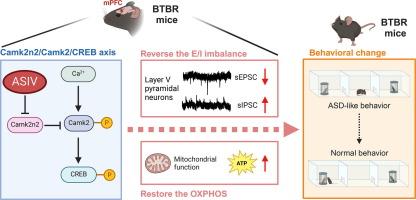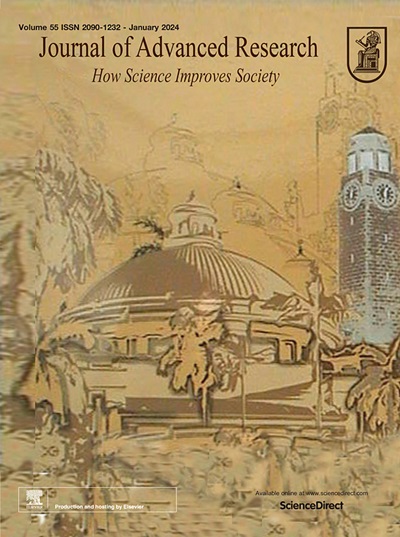黄芪甲苷通过调节camk2n2依赖性OXPHOS和mPFC中的神经传递改善BTBR小鼠的自闭症样行为
IF 11.4
1区 综合性期刊
Q1 MULTIDISCIPLINARY SCIENCES
引用次数: 0
摘要
自闭症谱系障碍(ASD)代表了以社会缺陷和重复行为为特征的多方面的神经发育状况。黄芪甲苷(Astragaloside IV, ASIV)是一种从传统中药黄芪中提取的天然化合物,具有强大的神经保护作用。然而,asv是否可以改善ASD的行为缺陷仍然未知。目的探讨asv治疗ASD的疗效及分子机制。方法采用自闭BTBR T + tf/J (BTBR)小鼠。行为测试评估asd样表型。分别用高效液相色谱法和全细胞膜片钳法测定神经递质水平和突触传递。结合分子生物学技术,免疫染色和rna测序(RNA-seq)来揭示潜在的分子机制。结果BTBR小鼠经asv治疗后,社交障碍和重复行为均有剂量依赖性改善。asv治疗使内侧前额叶皮层(mPFC)的神经递质(GABA和谷氨酸)及其相应的囊泡转运蛋白(vGAT, vGLUT1)水平正常化。此外,注射asv后,mPFC第V层的兴奋-抑制不平衡被逆转。在机制上,大量RNA-seq和PPI网络分析发现Camk2n2是调节氧化磷酸化和神经传递的关键桥接基因。mPFC中的Camk2n2过表达通过Camk2/CREB途径消除了asv对BTBR小鼠自闭症症状的有益作用。结论有证据表明,asv可能成为ASD的一种有前景的治疗选择,并表明靶向Camk2n2/Camk2/CREB轴是进一步研究这些ASD个体的必要条件。本文章由计算机程序翻译,如有差异,请以英文原文为准。

Astragaloside IV ameliorates autism-like behaviors in BTBR mice by modulating Camk2n2-dependent OXPHOS and neurotransmission in the mPFC
Introduction
Autism spectrum disorder (ASD) represents a multifaceted set of neurodevelopmental conditions marked by social deficits and repetitive behaviors. Astragaloside IV (ASIV), a natural compound derived from the traditional Chinese herb Astragali Radix, exhibits robust neuroprotective effects. However, whether ASIV can ameliorate behavioral deficits in ASD remains unknown.Objectives
This work aimed to determine the efficacy and molecular mechanisms of ASIV in ASD.Methods
The autistic BTBR T + tf/J (BTBR) mice were used in this study. Behavioral tests were performed to assess the ASD-like phenotypes. The neurotransmitter levels and synaptic transmission were evaluated by high-performance liquid chromatography and whole-cell patch-clamp recordings, respectively. Molecular biological techniques, immunostaining, and RNA-sequencing (RNA-seq) were combined to uncover the underlying molecular mechanisms.Results
Our study showed that both social impairment and repetitive behaviors were significantly improved after ASIV treatment in a dose-dependent manner in BTBR mice. The ASIV treatment normalized the neurotransmitter levels (GABA and glutamate) and their corresponding vesicular transporters (vGAT, vGLUT1) in the medial prefrontal cortex (mPFC). Furthermore, the excitation-inhibition imbalance in layer V of mPFC was reversed after ASIV administration. Mechanistically, bulk RNA-seq and PPI network analysis identified Camk2n2 as the crucial bridging gene regulating oxidative phosphorylation and neurotransmission. Camk2n2 overexpression in the mPFC abolished the beneficial effects of ASIV on autistic symptoms in BTBR mice via the Camk2/CREB pathway.Conclusion
The evidence demonstrates that ASIV may become a promising treatment option for ASD and implies that targeting the Camk2n2/Camk2/CREB axis is warranted to investigate these ASD individuals further.求助全文
通过发布文献求助,成功后即可免费获取论文全文。
去求助
来源期刊

Journal of Advanced Research
Multidisciplinary-Multidisciplinary
CiteScore
21.60
自引率
0.90%
发文量
280
审稿时长
12 weeks
期刊介绍:
Journal of Advanced Research (J. Adv. Res.) is an applied/natural sciences, peer-reviewed journal that focuses on interdisciplinary research. The journal aims to contribute to applied research and knowledge worldwide through the publication of original and high-quality research articles in the fields of Medicine, Pharmaceutical Sciences, Dentistry, Physical Therapy, Veterinary Medicine, and Basic and Biological Sciences.
The following abstracting and indexing services cover the Journal of Advanced Research: PubMed/Medline, Essential Science Indicators, Web of Science, Scopus, PubMed Central, PubMed, Science Citation Index Expanded, Directory of Open Access Journals (DOAJ), and INSPEC.
 求助内容:
求助内容: 应助结果提醒方式:
应助结果提醒方式:


